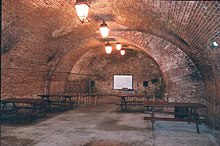casemate




A casemate is a vault in a fortress that is protected from artillery fire .
Word origin
Casemate is derived from the synonymous French casematte , which itself goes back to a central French casemate in Italian casamatta , "wall, fortress vault ". The origin of the Italian word is disputed; possible is an origin from ancient Greek χάσμα chásma "gaping opening, crevice , throat, earth chasm ", the plural of which is χάσματα chásmata , but also the combination of the Latin words casa , " little house, hut", and matta , "mat, made of reeds and the like existing ceiling ”is a conceivable starting form.
Casemates in the fortress construction
In the early fortress construction, the underground vaults built for defense purposes were also known as the murder pit . A casemate's bulletproof security was first achieved through thick walls and, in particular, through the vaulting, to which an earth cover was quickly added. With the introduction of explosive bullets in the 19th century , casemates made of concrete or reinforced concrete became necessary. Those walls that support vaults are called abutments or pillars, and those that connect the abutments with one another and close the vaults are called end walls. If the outer surrounding wall also serves as an abutment, the parallel casemate is obtained. If they are at right angles , one speaks of a perpendicular casemate. In this case, the collapse of the enclosing wall does not result in that of the ceiling.
A distinction was made between casemates for crews (residential and standby casemates) and those for storing supplies (storage casemates). Defense casemates or defense barracks were created for rifle or artillery defense . These could, for example, lead to the cannon yards on the bastion flank .
Casemate gun
In the case of ship armament and fortresses, the term casemate gun means that the gun is positioned behind an armored wall and the barrel is guided to the outside through a movable notch that rotates around an axis with the elevation of the gun. The cylindrical segment-like shape of this cover often gives the impression that a complete gun turret was built into the casemate, but this was almost never the case.
Casemate railways
In order to be able to better transport supplies in the narrow aisles of the casemates, from the 19th century onwards some casemates were equipped with so-called casemate railways, with which large quantities of military goods could be brought to their destination quickly and efficiently.
Examples of such casemate railways can be found on the Atlantic Wall , the fortifications in the Ardennes , the Maginot Line , in parts of the fortress front Oder-Warthe-Bogen ("Ostwall"), in parts of the Czechoslovak Wall and British port fortresses.
Casemates accessible to the public
Warship building
→ Main article: Casemate deck
The gun chambers of artillery armed warships built into the side of the hull were also called casemates (in contrast to the gun turrets).
See also
- Technical terms of fortress construction
- List of fortresses
- List of castles and palaces
- Casemate de Bourges
Web links
- Panoramic tour through the casemates of Sparrenburg , Bielefeld
- Heldsberg artillery casemate factory ( Memento from April 9, 2004 in the Internet Archive ) St. Margrethen , Switzerland .
Individual evidence
- ↑ Casemate. In: Digital dictionary of the German language . Retrieved on November 21, 2019 (section “Etymology”, excerpt from Wolfgang Pfeifer et al., Etymological Dictionary of German, 1993, digitized version in the digital dictionary of the German language revised by Wolfgang Pfeifer).
- ^ Website of the city of Kronach: Casemate tour. Retrieved September 12, 2015.
- ↑ For example the description of the liner 'Schleswig-Holstein' .
